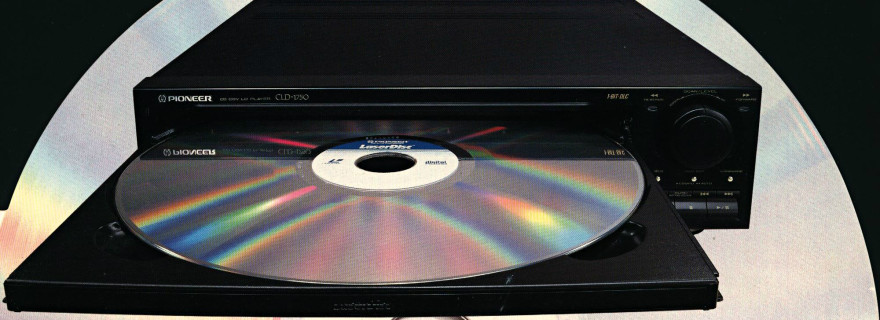 LaserDisc, The official device of every videophiles in the early 1990s and late 1980s. This video format is the definition of being ahead of its time. It was grand device in almost every way, for the time, but there was one factor that brought it down like for most revolutionary devices... the price. The players and the discs themselves were quite expensive compared to other formats at the time like VHS. Another contributing factor was the inability of the LaserDisc to record shows and other such things and the people unwillingness to change. Which really is such a sad thing because this is not exactly a bad format, the video and audio from these dinner plates of a disc are truly amazing compared to the stone age VHS.
LaserDisc, The official device of every videophiles in the early 1990s and late 1980s. This video format is the definition of being ahead of its time. It was grand device in almost every way, for the time, but there was one factor that brought it down like for most revolutionary devices... the price. The players and the discs themselves were quite expensive compared to other formats at the time like VHS. Another contributing factor was the inability of the LaserDisc to record shows and other such things and the people unwillingness to change. Which really is such a sad thing because this is not exactly a bad format, the video and audio from these dinner plates of a disc are truly amazing compared to the stone age VHS.
LaserDisc came out to market 2 years after the VHS in December 15, 1978 and 4 years before the CD (which was based on LaserDisc technology). It was released as DsicoVision by MCA and was commonly referenced as “video long play” due to the size of the disc. Pioneer Electronic would later buy majority of the brand and would help market it in 1980. The first LaserDisc would be released was Jaws in 1978 up to Bringing Out the Dead in 2000. And throughout this time LaserDisc was unable to have a grasp to cling on market share and was received it's finally blow when DVDs became popular in 2000. LaserDisc did do a bit better in the Japanese market, but still was not popular. Only 2% of households would have a LaserDisc player in 1998.
So how do these flying-saucer of a disc work? Well the technology work very similarly to that of DVD, CD, and even Blu Ray, but yet differently. While the previously mention formats are digital, LaserDisc are actually analog. This is how it works, the disc are 12 inches in diameter (compare that with a DVD’s 5 inches and yes that is not a typo) and instead of the laser reading digital 1 and 0, instead it is reading the ”pits” in the disc which are varied by the lengths and dash of the pit. The disc are double sided, so both sides are filled with these tiny pits. Also each side only contains 60 minutes which means only 120 minutes per disc and also means not getting too comfortable before the 60 minutes because this means that the disc has to be flipped (most later players have an automatic flip feature in them). The lasers are interesting because early LaserDisc players used a helium-neon laser at a wavelength of 628 nm until replaced with the diodes we used today which this this case are rated at 720 nm. The audio is also interesting because at first it was analog and read the same as the rest of the disc and later on in which the audio became digital and read more like a CD, improving audio quality. This gave it an advantage over the VHS because everything on a VHS has to be analog. While on the topic of LaserDisc being better than VHS, LaserDisc have a resolution than their magnetic tape counterparts and have chapters scene unlike with a VHS which requires fast forward or rewinding.
LaserDisc kinda reminds me of Ronald Reagan and his “StarWars” program. Although some may have viewed the LaserDisc as stupid or crazy, it turned out to be very beneficial at the end. While “StarWars” program gave us a high tech defence system, the LaserDisc gave us the CD, DVD, and Blu Ray technology which helped shape the world as we know it for the better.
Source:https://en.wikipedia.org/wiki/LaserDisc
https://en.wikipedia.org/wiki/Laserdisc_player



I had no idea LaserDiscs were analog. That is super interesting. I actually have a LaserDisc copy of Planet of the Apes. It's just decorative though, since I don't have a LaserDisc player like a buddy of mine. Some of his coolest parts of his collection are The Godfather, Toy Story, and A Streetcar Named Desire (a gift from me) and I'm just so jealous.
ReplyDelete